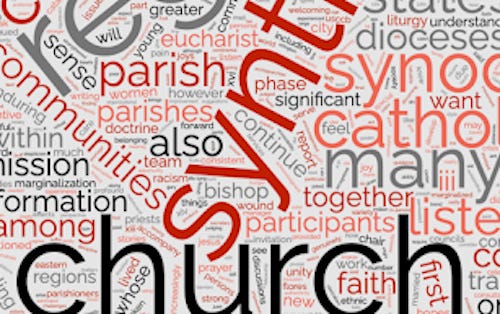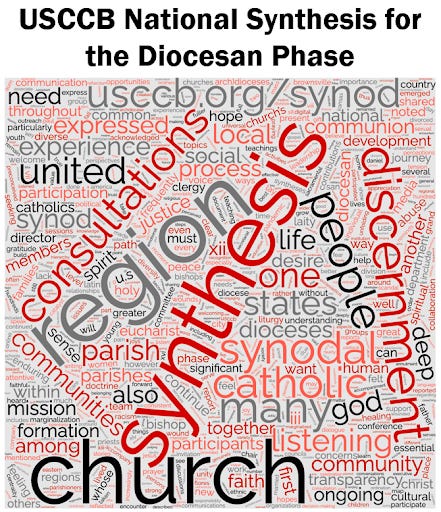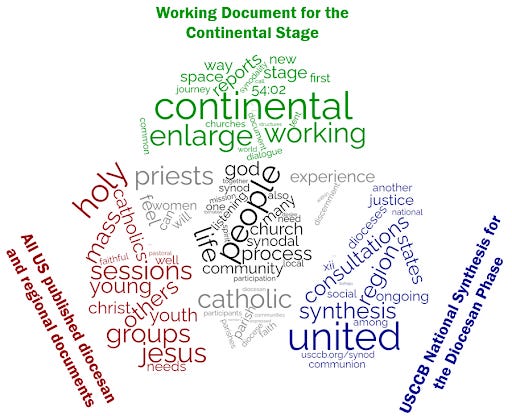
'Words, words, words' - Synodality synod reports, by the numbers
What are the most common words in the documents of the synod on synodality?

The Vatican on Thursday released a “Working Document for the Continental Stage” in the Church’s global synod on synodality.
The text is, according to Vatican officials, a synthesis of what Catholics around the world have said in local synod meetings. It will now form the basis for new synod documents, produced by continental gatherings of bishops, clergy, and laity.
It is a significant challenge to synthesize into an accurate summary the thoughts of Catholics meeting in tens of thousands of parish and diocesan gatherings. It is also a challenge to judge how accurate that summary really is.
But at The Pillar we’ve decided to give it a shot, using quantitative textual analysis, to get a sense of how synod documents from each level of the process have influenced each other. In a series of analytical experiments, we’ve aimed at gauging how the synod on synodality is going.
This report is the first part of that analysis.
To assess the synod by the numbers, we’ve collected and analyzed the synodal documents prepared by dioceses around the U.S., and American regiona reports- along with the USCCB’s national synthesis, which was submitted to the Vatican last month.
For the U.S. alone, the 129 published synodal summary documents total 515,730 words — nearly as long as the English translations of Leo Tolstoy’s “War & Peace.”
To compare that massive collection of prose with the 16,454 words of the “Working Document for the Continental Stage” is a challenge which can be addressed qualitatively or quantitatively. The Pillar took a look at the numbers.
Analyze the frequency of distinctive words is among the most basic approaches to quantitatively analyzing a large collection of text.
Some words such as “the”, “of”, “and”, and “a” are common in any piece of English prose, when analyzing the frequency of words in a document, these exceedingly common words are excluded in order to look at the frequency of words which are more specific to the specific work in question.
The Pillar used textual analysis programs to generate data sets and word cloud visualizations, offering a view of the most common words -excluding those generic, exceedingly common words- in the synodal documents.
In a word cloud, the size of a word is representative of how frequently the word appears in the document being analyzed.
Start your day with Starting Seven - a daily news roundup in your inbox.
“In the Working Document for the Continental Stage,” the most common words were “church,” “synodal,” “people,” “continental,” and “life.”
In the national summary produced by the USCCB - based on the input from all regions of the bishops’ conference - the most frequently used words were “church,” “synthesis,” “region,” “synodal,” and “people.
In the documents published by US dioceses, and in USCCB regional summary documents, the most common word (after exclusions) was “church,” followed by “people,” “parish,” “many,” and “faith.”
Perhaps unsurprisingly, the global document shared its most common word - “church” - with the USCCB summary documents and with the aggregation of regional and diocesan documents. All three data sets also had “synodal,” “people,” and “listening” among their most commonly found words.
In the U.S. diocesan and regional documents, the words “Mass,” “youth,” “Jesus,” “pastoral,” and “holy” were among the most frequently used 50 words. Those words did not appear among the top 50 words in the USCCB document or the global document.
In the USCCB document, words which appeared within the top 50 - but did not appear in the top 50 of either the global document or the combined diocesan and regional documents - included “communion,” “justice,” and “bishops.”
Words which appeared on the list of the 50 most frequent in the global document, but did not appear among the top words in the USCCB document or the compilation of all U.S. documents included “tent,” “journey,” “continental,” “dialogue,” and “structures.”
A Venn-diagram-style word cloud shows the overlap between the 50 most frequent words found in each document, weighted by how highly ranked each word is among the top 50.
The words in black are those with both the most overlap, and the most frequent use:






